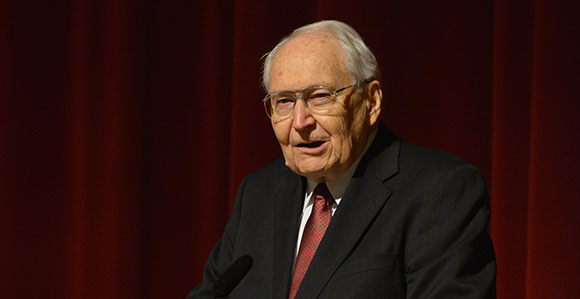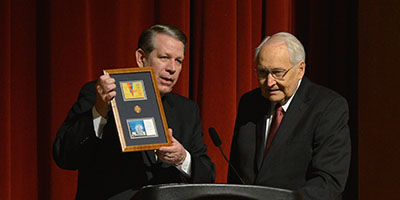“Become the Message” We Share, Elder Perry Says
Contributed By Laurie Williams Sowby, Church News staff writer.

Elder L. Tom Perry of the Quorum of the Twelve Apostles speaks at a banquet for the New York LDS Professionals Association, comprised of several thousand Church members in the New York metro area.
Article Highlights
- Elder L. Tom Perry gave the keynote address at an event for the New York LDS Professionals Association.
- Members should not rely on social media alone to share the gospel.
- Fifty years ago, the Mormon Pavilion at the World’s Fair put the Church on the map.
“There are individuals out there who need our examples of faith. We must never stop reaching out.” —Elder L. Tom Perry of the Quorum of the Twelve Apostles
Related Links
NEW YORK CITY
Despite the “remarkable period of technological advancement” 50 years after the Mormon Pavilion at the New York World’s Fair put the Church on the map, members should not depend on social media alone to spread the gospel message.
“Our goal as people is to become the message that we are spreading,” Elder L. Tom Perry of the Quorum of the Twelve Apostles told an audience of more than 400 gathered in Riverside Church, a New York City landmark, October 14. Elder Perry was the keynote speaker at the annual fundraising banquet of the New York LDS Professionals Association, comprised of several thousand members in the New York metro area.
In addition to naming 30 winners of fall semester scholarships, the organization honored both Elder Perry and Robert P. George, Princeton University political philosopher and constitutional scholar, with the NYLDSPA Visionary Leadership Award. Utah Valley University president Matt Holland presented the award.
Elder Donald L. Hallstrom of the Seventy lauded Elder Perry as “an advocate to move forward all religious traditions so we might unitedly accomplish God’s work on this earth.”
Dr. George, founding director of the James Madison Program in American Ideals and Institutions at Princeton, is vice chair of the United States Commission on International Religious Freedom (USCIR).
In touting Dr. George’s ability to gather support from various faiths to defend traditional marriage and religious liberty, President Holland said, “His most visionary quality rests in his ability to see the need for, and to generate, a veritable choir of voices in defense of certain light and truths.” Dr. George noted “unprecedented cooperation between faiths” in the struggle to defend the family and religious liberty.
In a short video with historical clips of the New York World’s Fair, which was held during the two summers of 1964 and 1965, Elder Perry spoke of religious faith as “the conscience of our nation.” He acknowledged that there are “doctrinal differences which will never change, but we have common ground among all of us.”
Elder Perry, 92, contrasted the ability of the Church today to rapidly spread its message via electronic media with his experiences a half-century ago when he was assigned to be an assistant to the director at the Mormon Pavilion.
When another group vacated an adjoining planned site, the result was a prime location for the Church’s venue. It was the first pavilion visible when riders exited the subway, Elder Perry explained. “The first thing they would see is the beautiful façade of the [Salt Lake] Mormon temple,” a replica built locally.
Inside, there was a Christus statue, copied from Bertel Thorvaldsen’s sculpture in Copenhagen, Denmark. And there was a film, Man’s Search for Happiness, created expressly for the Mormon Pavilion.
Elder Perry shared personal experiences such as having to set an alarm to wake him up before his train stop in Scarsdale, New York, on the two weeknights plus one weekend night when his assignment required him to be at the pavilion after work.

Elder Donald L. Hallstrom of the Seventy presents Elder L. Tom Perry with a gift commemorating the New York World’s Fair 50 years ago. Photo by Gerry Avant.

Those attending the LDS Professionals Association banquet give a standing ovation to the 2014 recipient of the Visionary Leadership Award, Professor Robert P. George of Princeton University, October 14, 2014.
Elder Perry paid tribute to three people whose work was critical to the pavilion’s success: Stanley McAlister, then president of the New York Stake, who “convinced the Church to proceed”; then-Elder Harold B. Lee, assigned to move the project forward, who was well-respected by the fair’s board members and “was the real force behind our participation”; and Elder Bernard P. Brockbank, Assistant to the Quorum of the Twelve Apostles, who moved from Salt Lake City to direct the pavilion’s daily affairs.
One of the most memorable days—and the largest for attendance at the pavilion—was when the Mormon Tabernacle Choir gave a special concert in 1964. “We were overwhelmed by its success,” Elder Perry recalled.
The World’s Fair 50 years ago resulted in great public affairs and missionary opportunities, he told the audience. The size, beauty, and location of the exhibit brought visibility to the Church. “We started to be recognized as a major part of the Christian religious community,” Elder Perry said.
“I believe it changed our approach to the way we present ourselves to the world.” (The Christus has since become a standard feature of LDS visitors’ centers. Man’s Search for Happiness, used by missionaries for years after the fair, was the first in a long line of film and video created to introduce the Church and its message across the globe.) Missionary work blossomed.
“It was the first opportunity to really build the Church in the New York area,” said Elder Perry. “There is a spirit of vitality that has continued to this day.” Additionally, advances in technology have helped the Church “reach millions in a way we could only dream about during the New York World’s Fair,” said Elder Perry.
He mentioned the expanding Newsroom website, which provides information tailored specifically for the media and various opinion leaders in different countries.
For example, infographics on Newsroom quickly explain such things as temple construction projects or the Church’s welfare or humanitarian aid programs around the globe.
A weekly series entitled “In Your Own Words” features unfiltered samples of social media content posted by members of the Church. Public Affairs has a new website, JustServe, soon to be rolled out to the western United States and Canada, to help members and nonmembers alike identify opportunities for volunteer service and then connect with others to make it happen. Elder Perry said 20,000 people are already signed up on the website, with 2,100 projects in progress. JustServe “provides opportunities for us to interact with people not of our faith but on common ground,” he emphasized.
The new FaithCounts initiative (http://faithcounts.net) is a result of relationships built through outreach with many leaders of other faiths. “It is a joint social media effort to promote the value of faith in society,” Elder Perry explained.
The Church has partnered with the U.S. Conference of Catholic Bishops, the Seventh-day Adventist Church, several Evangelical Christian denominations, Jewish and Sikh groups, and others, he said, to “create a platform to tell stories of faith through videos, articles, and images” on various social media channels.
“Each partner is working hand-in-hand with the others to give a voice to faith by utilizing the remarkable means of communication available to us,” he said. “Ultimately, the goal of the interfaith alliance is to generate a movement that shows why faith is so important to us as individuals, families, communities, and societies.” Elder Perry asked those in the audience—many of them non-LDS, “If the reputation of your church depended on you, how would your church be doing?”
In urging listeners to “become the message that we are spreading,” he added: “We can always do more to reach out and set examples of Christlike behavior to those who are not of our faith and build faith in this great land of the free. …
“There are individuals out there who need our examples of faith,” he said. “We must never stop reaching out.”
